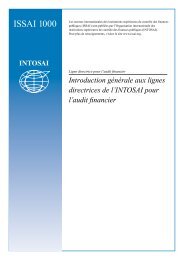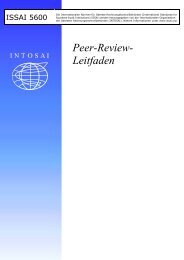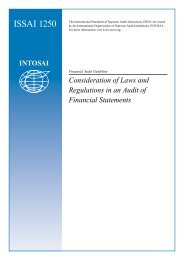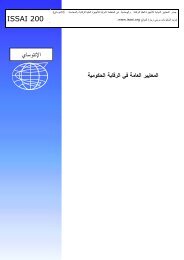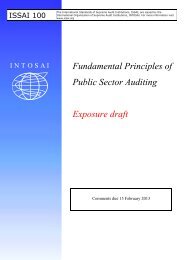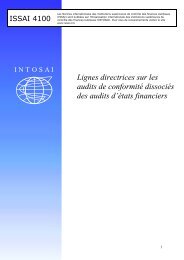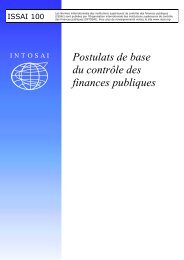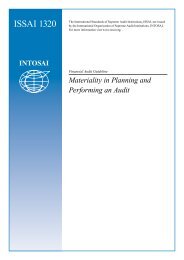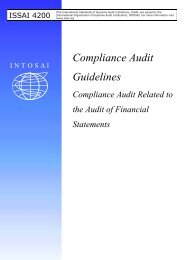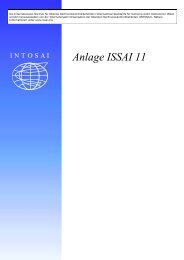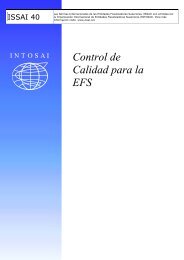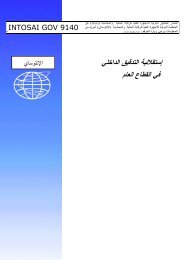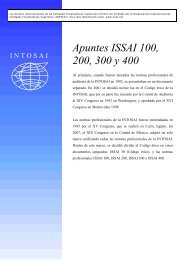ISSAI 1240
ISSAI 1240
ISSAI 1240
Create successful ePaper yourself
Turn your PDF publications into a flip-book with our unique Google optimized e-Paper software.
<strong>ISSAI</strong> <strong>1240</strong><br />
ISA 240<br />
THE AUDITOR’S RESPONSIBILITIES RELATING TO<br />
FRAUD IN AN AUDIT OF FINANCIAL STATEMENTS<br />
basis. Fraudulent financial reporting is often accomplished through intentional<br />
misstatement of accounting estimates. This may be achieved by, for example,<br />
understating or overstating all provisions or reserves in the same fashion so as<br />
to be designed either to smooth earnings over two or more accounting periods,<br />
or to achieve a designated earnings level in order to deceive financial statement<br />
users by influencing their perceptions as to the entity’s performance and<br />
profitability.<br />
A46. The purpose of performing a retrospective review of management judgments<br />
and assumptions related to significant accounting estimates reflected in the<br />
financial statements of the prior year is to determine whether there is an<br />
indication of a possible bias on the part of management. It is not intended to<br />
call into question the auditor’s professional judgments made in the prior year<br />
that were based on information available at the time.<br />
A47. A retrospective review is also required by ISA 540. 18 That review is conducted<br />
as a risk assessment procedure to obtain information regarding the<br />
effectiveness of management’s prior period estimation process, audit evidence<br />
about the outcome, or where applicable, the subsequent re-estimation of prior<br />
period accounting estimates that is pertinent to making current period<br />
accounting estimates, and audit evidence of matters, such as estimation<br />
uncertainty, that may be required to be disclosed in the financial statements. As<br />
a practical matter, the auditor’s review of management judgments and<br />
assumptions for biases that could represent a risk of material misstatement due<br />
to fraud in accordance with this ISA may be carried out in conjunction with the<br />
review required by ISA 540.<br />
Business Rationale for Significant Transactions (Ref: Para. 32(c))<br />
A48. Indicators that may suggest that significant transactions that are outside the<br />
normal course of business for the entity, or that otherwise appear to be unusual,<br />
may have been entered into to engage in fraudulent financial reporting or to<br />
conceal misappropriation of assets include:<br />
• The form of such transactions appears overly complex (for example, the<br />
transaction involves multiple entities within a consolidated group or<br />
multiple unrelated third parties).<br />
• Management has not discussed the nature of and accounting for such<br />
transactions with those charged with governance of the entity, and there is<br />
inadequate documentation.<br />
• Management is placing more emphasis on the need for a particular<br />
accounting treatment than on the underlying economics of the transaction.<br />
18<br />
ISA 540, “Auditing Accounting Estimates, Including Fair Value Accounting Estimates, and Related<br />
Disclosures,” paragraph 9.<br />
28<br />
The Auditor’s Responsibilities Relating to Fraud in an Audit of Financial Statements 263



